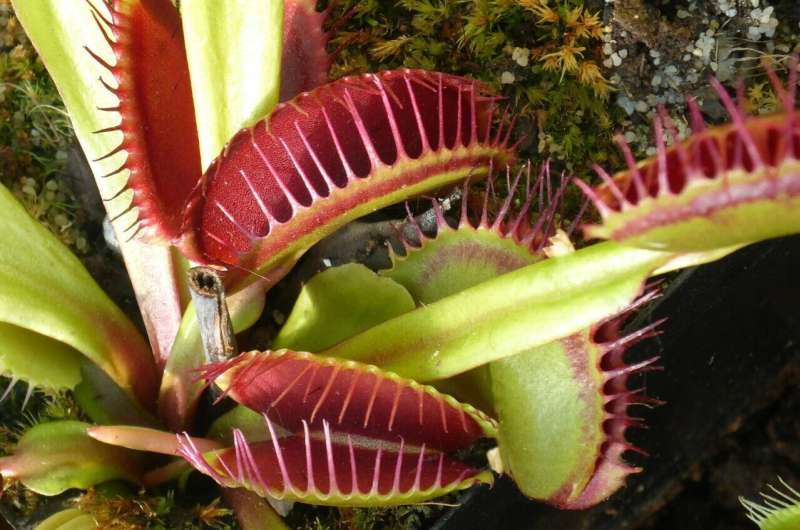Credit: CC0 Public Domain
The brush of an insect's wing is enough to trigger a Venus flytrap to snap shut, but the biology of how these plants sense and respond to touch is still poorly understood, especially at the molecular level. Now, a new study by Salk and Scripps Research scientists identifies what appears to be a key protein involved in touch sensitivity for flytraps and other carnivorous plants.
The findings, published March 16, 2021, in the journal eLife, help explain a critical process that has long puzzled botanists. This could help scientists better understand how plants of all kinds sense and respond to mechanical stimulation, and could also have a potential application in medical therapies that mechanically stimulate human cells such as neurons.
"We know that plants sense touch," says co-corresponding author Joanne Chory, director of Salk's Plant Molecular and Cellular Biology Laboratory and holder of the Howard H. and Maryam R. Newman Chair in Plant Biology. "The Venus flytrap, which has a very fast response to touch, provides an opportunity to study a sensory modality that historically has been poorly understood."
Scientists have long been fascinated by Venus flytraps and carnivorous plants; Charles Darwin devoted an entire book to them. But while previous studies have looked at the structural mechanism of their bizarre leaves, not much is known about how they work at the cellular level. That's partly because flytraps are challenging to study. They're extremely slow to grow, and the flytrap genome had not been sequenced until recently, opening the door for deeper genetic research.
"Because they're so unusual, people have been interested in these plants for hundreds of years, so there's quite a bit known about them at the gross, macroscopic level, but the molecular details have been hard to tease out," says Carl Procko, a staff scientist in Salk's Plant Molecular and Cellular Biology Laboratory.
Research by Salk scientists helps explain how plants sense touch, and could have medical applications. Credit: Salk Institute
In the new study, the authors grew cloned flytraps from cuttings to get plants that were genetically identical. Then they carefully cut thousands of microscopic, touch-sensitive trigger hairs from these plants and used sequencing technology to identify which proteins were most abundant in the hairs.
Based on previous research, they knew that the proteins involved in sensing touch were likely to have the capability of moving an electrical current across the cell. Sure enough, this type of protein was the second most common type found in the hairs. The scientists named the new protein FLYCATCHER1. To test the protein, colleagues at Scripps Research put it into mammalian cells. The cells responded by producing an electrical current when touched, proving that the protein is sensitive to mechanical stimuli.
The team found the same protein in the tentacles of the sundew, a carnivorous plant that's a close relative of the Venus flytrap. In the sundew, these sticky tentacles sense the movement of a struggling insect, stimulating the leaf to curl up and trap its prey.
"These findings are further evidence that the FLYCATCHER1 protein plays a critical role in the trigger hairs of the Venus flytrap and the mechanisms of the plant that sense and respond to touch," says Chory.
As a next step, the study authors want to do a 'knockout' test and grow genetically modified flytraps with the protein missing. If these flytraps are unable to sense touch, it will prove conclusively that the FLYCATCHER1 protein is responsible.
More information: Carl Procko et al, Stretch-activated ion channels identified in the touch-sensitive structures of carnivorous Droseraceae plants, eLife (2021). DOI: 10.7554/eLife.64250
Provided by Salk Institute
























